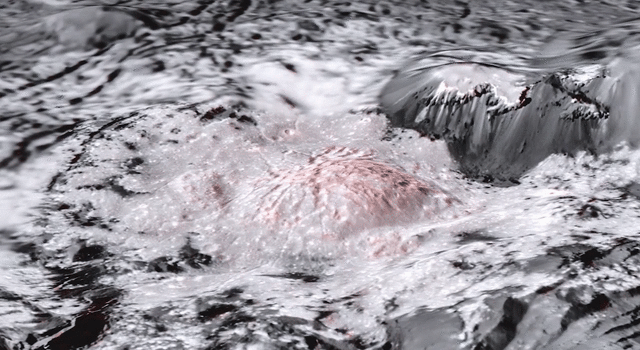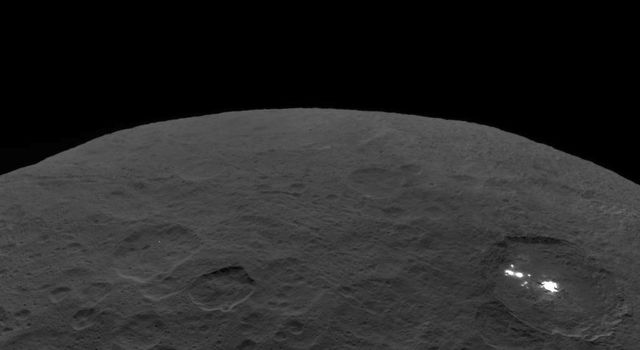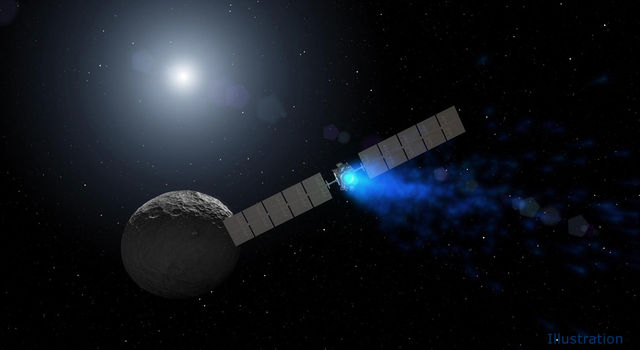Blogs | Dawn Journal | May 31, 2018
Dear Expecdawnt Readers
Propelled by the perfect combination of xenon ions, hydrazine rocket propellant and adrenaline, Dawn is on the verge of its most ambitious exploits yet. Having flawlessly completed its latest assignment to study Ceres, the veteran explorer is now aiming for a new low. Earlier today Dawn ignited ion engine #2 to start maneuvering to its lowest altitude above the dwarf planet. Soon the spaceship will be skimming closer to the alien landscapes of rock, ice and salt than ever before, promising exciting new insights into the nature of a distant and mysterious world.
Almost once a day in its next orbit, Dawn will dive from 2,500 miles (4,000 kilometers) down to only 22 miles (35 kilometers), speeding above the ground at 1,050 mph (1,690 kph), and then shoot back up again. (Warning: Do not try this at home! Dawn is a trained professional.)
Before we (and Dawn) get to this new and final orbit, let's review the outstanding accomplishments this month. Dawn used its ion engine in April and May to descend to an orbit creatively known as extended mission orbit 6 (XMO6). (We showed the flight path last month and tracked the progress in mission status updates.) Ion thrusting concluded on schedule on May 14 when Dawn was in the targeted elliptical orbit, which ranged from 280 miles (450 kilometers) to 2,900 miles (4,700 kilometers).
Each of the 10 loops around Ceres took one and a half days, and Dawn successfully performed all of its planned observations. Every time Dawn flew northward over the sunlit hemisphere, the spacecraft used its cameras and other sensors to collect new data. During some orbits, as it flew southward over the hemisphere opposite the Sun, it turned to point its main antenna at faraway Earth and then radioed its findings to NASA's Deep Space Network. On other orbits, Dawn patiently continued looking down at Ceres. Of course, with the ground there hidden in the deep black of night on a moonless world, there was nothing to see, but by not turning, the spacecraft could conserve precious hydrazine for later in the mission. (Dawn used this strategy in most of the other phases at Ceres as well, starting with the third mapping orbit of the prime mission in 2015.) We will discuss more about hydrazine below.

As we saw in March's preview, Dawn's primary goal in XMO6 was to take advantage of it being summer in the southern hemisphere by making extensive observations in the far south. We also explained that XMO6 provided an opportunity for collecting new data (including higher resolution color pictures), providing new perspectives closer to the equator and in the northern hemisphere as well. Dawn spotted sites we have discussed before, including Ernutet Crater with deposits of organic materials, the smooth landscape around Ikapati Crater showing a history of flowing material, the volcano Ahuna Mons and other locations pictured above and below. Prior to three years ago, these places were all quite unknown (at least to Earthlings). In the intervening time, Dawn has studied many of them in exquisite detail, and at each one has discovered new questions to ask. XMO6 may provide new answers (and probably still newer questions.)
In addition to its normal photography and spectroscopy, the spacecraft took long exposure pictures to investigate areas that are in shadow throughout the Cerean year. We described before how water can be trapped in such locations, but when we last touched on this topic in December 2016 (along with a cool animation), we also mentioned that the seasons had precluded a good study in the southern hemisphere. XMO6 has helped rectify that, illustrating one benefit of being able to stay in orbit rather than catching whatever is to be seen during a fast flyby.
Dawn had one more assignment in XMO6. After the primary scientific observations were complete on the first, third, and tenth orbits, the spacecraft turned from pointing at the ground beneath it to the horizon. (The amount of hydrazine needed for a turn depends on the direction. In each case, mission controllers selected the most hydrazine-efficient direction.) As it turned, Dawn continued taking pictures. This showed terrain at new angles, contributing to the collection of stereo pictures taken in the third and fourth mapping orbits. But in this case, the scientific benefit, while real, was secondary. The primary objective was to get some cool new views of the limb of Ceres, including the one above. Loyal readers (and some others as well) may know that your correspondent finds such perspectives especially appealing, as described here (with other fine examples here, there and elsewhere). He decided the pure coolness of these XMO6 pictures would be reason enough to instruct Dawn to take them.
By the time Dawn completed XMO6, it had collected 1,800 new photos of Ceres in addition to a wealth of infrared spectra and visible spectra. As soon as its bounty was safely on Earth, the itinerant adventurer was ready for its next great challenge.
And now the blue lights are on again in mission control at JPL, as they were at the end of last month. The illumination is not designed to alter the circadian rhythm of the flight team but rather to provide a visual connection with the distant spacecraft as its ion engine emits a steady bluish glow. Dawn is now spiraling down, tightening its elliptical loops, getting lower and lower and lower. We described the previous descent last month, and you can see the current trajectory in the figure below.

Dawn will spend the rest of its operational life in the target orbit, XMO7, and most future Dawn Journals will be devoted to it. How long will that be? That's a good question (in contrast, perhaps, to all the absurd questions posed in previous Dawn Journals), but the answer is not easy.
We have discussed many times (here is a summary) that Dawn's lifetime is limited by its hydrazine, a conventional rocket propellant expelled from reaction control system thrusters to control its orientation in space. When that dwindling supply is exhausted, the robot will no longer be able to point its solar arrays at the Sun, its antenna at Earth, its sensors at Ceres or its ion engines in the direction needed to travel elsewhere. The mission will end, and the ship will become an inert celestial monument to the power of human ingenuity, creativity and curiosity, a lasting reminder orbiting one of the solar system worlds it unveiled that our passion for bold adventures and our noble aspirations to extend our reach into the universe can take us very, very far beyond the confines of our humble planetary home.
The rate at which Dawn consumes hydrazine depends very strongly on the nature of the orbit. The lower the height, the faster it uses hydrazine, because it must rotate more quickly to keep its sensors pointed at the ground. In addition, it has to fight harder to resist Ceres’ relentless gravitational tug on the very large solar arrays, creating an unwanted torque on the ship. In XMO7, Dawn will dip to less than one-tenth of its lowest altitude so far. The hydrazine is going to go fast. But that's okay. The hydrazine is there to be used in service of accomplishing the mission, and Dawn is going to use it very well indeed as it pursues fabulous new goals.

Dawn engineers have sophisticated mathematical models to predict just how quickly the hydrazine will be spent, and those models have done an excellent job throughout the mission. Nevertheless, as in all realistic and complex systems, there remains some degree of uncertainty. (As a courtesy to most readers, we will not delve into the recondite details.) We can predict only approximately how fast Dawn will expend hydrazine as it carries out its intricate assignments in the coming months. Glitches, which are inevitable on such a complex mission, can both consume hydrazine and compel the flight team to change the schedule and the plans, introducing further uncertainty.
As it turns out, there are two more aspects of this problem. Not only are we limited in our ability to predict how much hydrazine each activity will require but our measurement of how much hydrazine Dawn has remaining is imperfect too. We know that when it left Earth, riding atop a Delta rocket, the 12-gallon (45-liter) hydrazine tank was filled with 99.8 pounds (45.3 kilograms) of the propellant. In the subsequent 11.5 years, every time it has fired a thruster, the spacecraft has dutifully recorded the duration (in milliseconds) and reported that to mission control at JPL. It has also sent telemetry on the temperature and pressure in the hydrazine tank. With that information, engineers can calculate how much hydrazine is expended in each pulse of a thruster and, more to the point, how much is left in the tank. It is now down to about 1.8 gallons (7 liters). But no physical measurement is perfectly accurate. As only one example, the sensors that read the temperature and pressure have been subjected to violent shaking during the rocket's fiery ascent as well as almost a dozen years in space. Their readings now may be off a little bit one way or the other. The determination of how much hydrazine is still onboard thus has some uncertainty.
So, it is not possible to predict exactly how much hydrazine Dawn will need nor exactly how much it has. There is still another source of uncertainty. There is a complex network of tubing, valves and a filter between the tank and each of the 12 thrusters located around the spacecraft. Once the pressure in the lines is too low for a thruster to operate, the remaining hydrazine cannot be expelled. Of course, engineers can calculate how much of the hydrazine will be trapped in the system (known as the unusable hydrazine). That turns out to be 1.7 pints (0.8 liters), but, as with these other problems, they cannot know the answer with absolute precision, so it could be a little more or a little less.
Taken together, all these reasons prevent controllers from being able to pin down the day and time that Dawn will deplete the usable hydrazine. Experienced interplanetary explorers, like the Dawn flight team at JPL, are accustomed to dealing with such uncertainty.

The team will continue to guide Dawn in squeezing as much out of its time at Ceres as possible, acquiring new data until the spacecraft is unable to comply because it has expended the last puff of hydrazine. Right now, that is deemed most likely to be in September of this year (with a smaller chance it will be in August or maybe even October). Once Dawn has settled in to XMO7, and engineers have operational experience in the new orbit, they will update their estimate, and they will continue to refine it as the mission progresses.
And when the last of the hydrazine is used up, the spacecraft will actuate valves and try to fire thrusters to control its orientation, but hydrazine will no longer flow, so the torque it wants to exert will not be achieved. The spacecraft will be impotent, its attempts to point correctly futile. The struggle will be brief, as it will soon run out of electrical power, and the central computer will cease operating. We will address the details of its final moments in a future Dawn Journal.

For now, we needn't anticipate the end with despair. Dawn has already succeeded beyond our wildest expectations. The prime mission accomplished far more than planned at Vesta and at Ceres even though it confronted completely unanticipated and daunting obstacles, like the failures of two reaction wheels. The first extended mission (in XMO1 through XMO5) yielded many additional impressive bonuses as well as another reaction wheel failure. Now the second extension has provided further rewards in XMO6. And as we look ahead to XMO7, we can expect even more riches and, of course, more challenges (although no more reaction wheel failures).
A daring and exciting interplanetary adventure, journeying through the solar system atop a bluish beam of xenon ions, soaring past Mars and flying well over one million times farther from Earth than the International Space Station, orbiting Vesta and Ceres, the two largest bodies in the main asteroid belt (together representing about 40 percent of the combined mass of the millions of objects between Mars and Jupiter), exploring these mysterious uncharted worlds, revealing dramatic alien landscapes, powered by the collective passions of everyone exhilarated by new knowledge and everyone who longs to know the cosmos, Dawn has already surpassed any reasonable expectation for what it might achieve. What more may come, we do not yet know. That's part of the thrill of exploration and discovery. But when the end does come, it will represent the culmination of a truly extraordinary extraterrestrial expedition.
Dawn is 1,800 miles (2,900 kilometers) from Ceres. It is also 2.73 AU (254 million miles, or 408 million kilometers) from Earth, or 1,010 times as far as the Moon and 2.69 times as far as the Sun today. Radio signals, traveling at the universal limit of the speed of light, take 45 minutes to make the round trip.
Dr. Marc D. Rayman
6:30 pm PDT May 31, 2018







